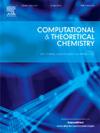Theoretical insights into the optoelectronic properties of (1,1′-biphenyl-1-H-imidazol-2-yl)methanone derivatives: DFT, CDFT and TD-DFT analysis
IF 3
3区 化学
Q3 CHEMISTRY, PHYSICAL
引用次数: 0
Abstract
In this study, the compounds (4′-diphenylamino)-[1,1′-biphenyl]-4)(4-(4′-(diphenylamino)-[1,1′-biphenyl]-4)-1-methyl-1H-imidazol-2-yl)methanone (L1-Methyl), (4′-diphenylamino)-[1,1′-biphenyl]-4)(4-(4′-(diphenylamino)-[1,1′-biphenyl]-4)-1-octyl-1H-imidazol-2-yl)methanone (L1-Octyl), (4’-9H-carbazol-9-yl)-[1,1′-biphenyl]-4)(4-(4’-9H-carbazol-9-yl)-[1,1′-biphenyl]-4)-1-methyl-1H-imidazol-2-yl)methanone (L2-Methyl), (4’-9H-carbazol-9-yl)-[1,1′-biphenyl]-4)(4-(4’-9H-carbazol-9-yl)-[1,1′-biphenyl]-4)-1-octyl-1H-imidazol-2-yl)methanone (L2-Octyl) were evaluated for optoelectronic properties in the gas phase, using Density Functional Theory (DFT), Conceptual Density Functional Theory (CDFT) and Time-Dependent Density Functional Theory (TD-DFT) calculations. Through TD-DFT calculations, various charge transfer (CT) parameters, such as the disparity between the overall extent of electron-hole spatial extension and the distance of CT (tindex), overlap parameter (Sr), electron-delocalization index (EDI), hole-delocalization index (HDI), binding energies, excitation energies, transition density matrices (TDM), transition dipole moment densities (TDMD), ghost hunter indices, and charge transfer spectra (CTS), were employed to investigate the electron excitation processes in five different excited states, revealing a comprehensive description of these excited state parameters. Notably, local excitations were observed consistently throughout all excited states in the compounds, which is desirable for luminescence. Moreover, a correlation between electron-hole overlap and the length of the alkyl chain was also observed, which was consistent with various other parameters such as Cele, Chole, RMSD of electron, RMSD of hole, reorganization energies (λe and λh), electronic coupling (te and th), ionization potential (IP), electron affinity (EA), hardness (η), electronegativity (χ), electron donating powers (ω−) and electron accepting powers (ω+), localized orbital locator π-over plane (LOLIPOP), radiative lifetimes (τ), molar emission coefficients (εem), and molar absorption coefficients (εAbs). Through CDFT calculations, a potential radical attack on the carbonyl moiety of each compound was identified, explained using the Intrinsic Bond Strength Index (IBSIIGMH) derived from the Hirshfeld partition. This descriptor can aid in enhancing the lifespan of OLED devices. Covalent character was observed across all the compounds, which could contribute to their stability and performance in optoelectronic applications.

(1,1 ' -联苯-1- h -咪唑-2-基)甲烷衍生物光电性质的理论见解:DFT、CDFT和TD-DFT分析
在本研究中,化合物(4′-二苯胺)-[1,1′-联苯]-4)(4′-(二苯胺)-[1,1′-联苯]-4)-(4′-(二苯胺)-[1,1′-联苯]-4)-(4′-(二苯胺)-[1,1′-联苯]-4)-(4′-(二苯胺)-[1,1′-联苯]-4)-(1′-(二苯胺)-[1,1′-联苯]-4)-[1,1′-联苯]-4)-[1,1′-联苯]-4)-[1,1′-联苯]-4)-[1,1′-联苯]-4)-[1,1′-联苯]-4)-[1,1′-联苯]-4)-[1,1′-联苯]- 1-甲基- 1h -咪唑-2-基)甲烷酮(l1 -甲基),利用密度泛函理论(DFT)、概念密度泛函理论(CDFT)和时变密度泛函理论(TD-DFT)计算,评价了(4 ' - 9h -carbazol-9-yl)-[1,1 ' -联苯]-4 (4 ' - 9h -carbazol-9-yl)-[1,1 ' -联苯]-4)-1-辛基- 1h -咪唑-2-yl)甲烷(L2-Octyl)在气相中的光电性能。通过TD-DFT计算,得到电子-空穴空间扩展总体程度与CT距离的差值(tindex)、重叠参数(Sr)、电子离域指数(EDI)、空穴离域指数(HDI)、结合能、激发能、跃迁密度矩阵(TDM)、跃迁偶极矩密度(TDMD)、幽灵猎人指数、电荷转移谱(CTS)等电荷转移(CT)参数。研究了五种不同激发态下的电子激发过程,揭示了这些激发态参数的综合描述。值得注意的是,在化合物的所有激发态中都观察到一致的局部激发,这是发光所需要的。此外,还观察到电子-空穴重叠与烷基链长度之间的相关关系,这与其他参数如Cele、Chole、电子RMSD、空穴RMSD、重组能(λe和λh)、电子耦合(te和th)、电离势(IP)、电子亲和力(EA)、硬度(η)、电负性(χ)、给电子功率(ω−)和接受电子功率(ω+)、定域轨道定位器π-over plane (LOLIPOP)、辐射寿命(τ)、摩尔发射系数(εem)和摩尔吸收系数(εAbs)。通过CDFT计算,确定了每种化合物羰基部分的潜在自由基攻击,并使用从Hirshfeld划分中得出的固有键强度指数(IBSIIGMH)进行了解释。这个描述符可以帮助提高OLED设备的使用寿命。在所有化合物中都观察到共价特征,这可能有助于它们在光电应用中的稳定性和性能。
本文章由计算机程序翻译,如有差异,请以英文原文为准。
求助全文
约1分钟内获得全文
求助全文
来源期刊

Computational and Theoretical Chemistry
CHEMISTRY, PHYSICAL-
CiteScore
4.20
自引率
10.70%
发文量
331
审稿时长
31 days
期刊介绍:
Computational and Theoretical Chemistry publishes high quality, original reports of significance in computational and theoretical chemistry including those that deal with problems of structure, properties, energetics, weak interactions, reaction mechanisms, catalysis, and reaction rates involving atoms, molecules, clusters, surfaces, and bulk matter.
 求助内容:
求助内容: 应助结果提醒方式:
应助结果提醒方式:


